
by Eddie Powell | Apr 14, 2015
Growing wholesome, healthy vegetables in a container are a way of life these days. Here are some easy and less expensive tips for creating that bucket garden.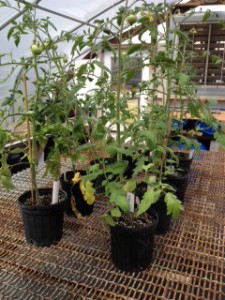
- In a large container or on a plastic mat on the ground, mix garden soil and compost in a 2:1 ratio. Two scoops of soil and one of compost, add the recommended quantity of slow release fertilizer from product label
- Drill 6 to 8- ½ inch holes in the bottom of the 5-gallon buckets. Make sure that the buckets did not contain toxic materials!
- Line the bottom of the bucket with gravel. You may substitute broken pottery or sticks that are broken in short links
- Fill the bucket to within 3 inches of the top of the container
- Place container in sunny spot that will allow drainage
- Plant chosen vegetable with two seeds in center of the container
- Water well and keep moist but not wet
- Place plant support around seeds
Plant requirements:
- Nutrients. Basic needs in plants are Nitrogen (N), Phosphorus (P), Potassium (K). These are listed on all fertilizers as a ratio, example – 8-8-8 contains 8% Nitrogen, 8% Phosphorus, and 8% Potassium and the remaining 76% is a filler. Soils contain many more trace minerals and they are listed on the fertilizer label including directions for use and amounts
- Sunshine or artificial sources of light (grow lights).
- Water. Soil must be kept moist but not wet. Wet soils will create root-rot and encourage fungus. Measure moisture by pinching the soil to see that the soil is moist but never wet. Adding water as needed; plants in hot areas will need much more water than plants in cool spots. Wilted plants need more water!
- Carbon Dioxide (CO2). Plants absorb CO2 and give off Oxygen making them VERY important to human and all animal life.
- Proper Temperatures. Plants will die when it is either too hot or too cold. Make sure that if your plants are outside and the temperature goes below freezing, the plants must be protected or brought inside.
Resources:
by Julie McConnell | Apr 13, 2015
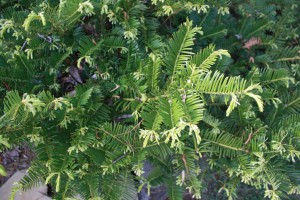
New foliage of Japanese Plum Yew Photo credit: Julie McConnell, UF/IFAS
Trying to grow turfgrass in shaded areas is a losing battle but that doesn’t mean you have to settle for mulch in those dark areas of the landscape. There are many plants that will tolerate shady conditions found under the canopy of large trees, and some offer year round interest!
One of the most important aspects of site assessment is sun exposure. Plants need light, but do not all need the same amount or intensity.
If plants requiring full sun are planted in the shade, they tend to get leggy and do not flower well. Although they may live, they will not perform at their peak.
Shade loving plants grown in the sun may be stunted, show leaf scorch, and will struggle. Most shade plants can tolerate some filtered light or morning sun, but need to be protected from direct mid-day to afternoon sun.
So, what evergreen plants can add some color and texture to your shaded spots?
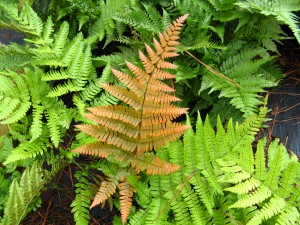
Golden tones of new foliage is what gives Autumn Fern its common name. Photo credit: Julie McConnell, UF/IFAS

Cast Iron Plants under a live oak tree. Photo credit: Julie McConnell, UF/IFAS
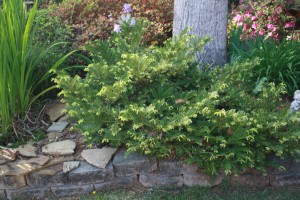
Japanese Plum Yew. Photo credit: Julie McConnell, UF/IFAS
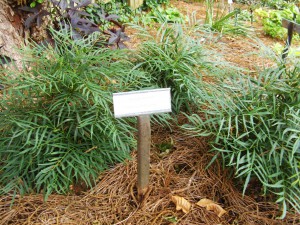
Soft Caress Mahonia. Photo Credit: Julie McConnell, UF/IFAS
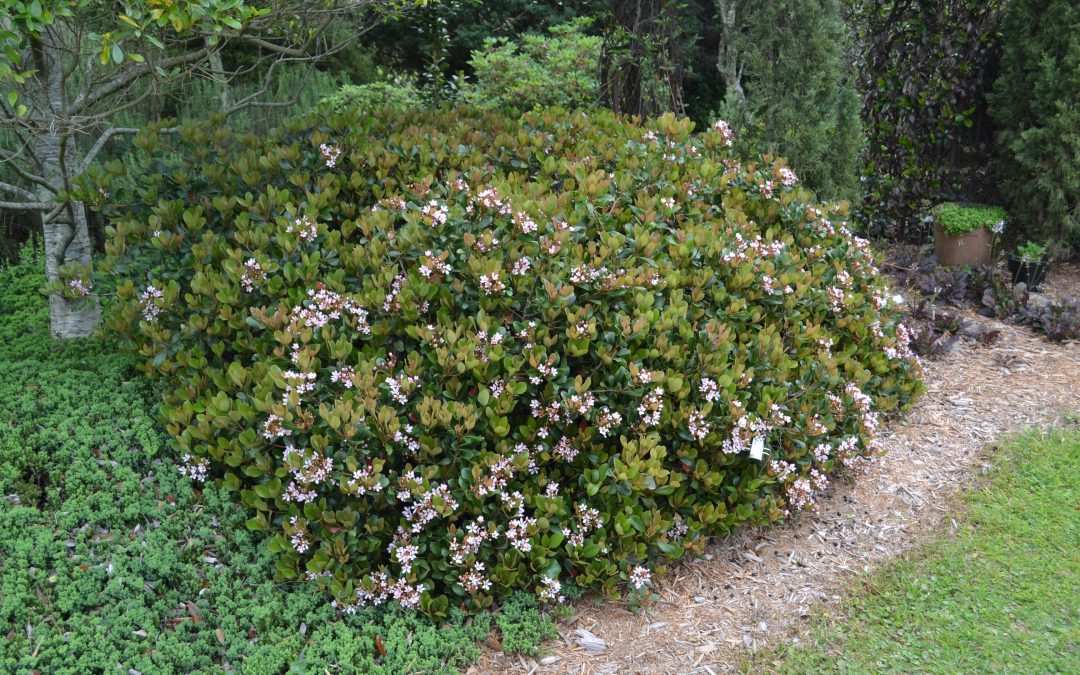
by Beth Bolles | Apr 7, 2015
One of the most commonly used shrubs in landscapes is the Indian hawthorn, Rhapheolepsis indica. Although not native to Florida, it can be a very attractive shrub when used properly in landscapes. Plants offer spring flowers in pinks and whites followed by berries that are a food source for birds.
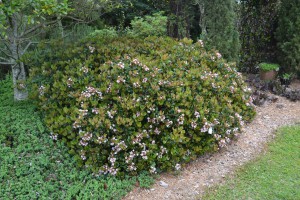
Indian hawthorn as a single planting can be attractive.
Indian hawthorn plants in landscapes are susceptible to a couple of pests that create unattractive and unhealthy plants. A leaf spot fungus called Entomosporium leaf spot easily spreads from infected plants through irrigation and rainfall leading to leaf discoloration, leaf drop, and dieback of limbs. Scale insects can also be common on leaves causing yellowing and dieback. The fungal problem is difficult to manage on heavily infected plants but the scale can be managed with a low toxicity pesticide choice such as a horticulture oil.

A heavy infection of leaf spot fungi is often too difficult to manage when plants are routinely irrigated.
Most often the problems on Indian hawthorn, especially fungal, are the result of poor management. This shrub likes sun, well-drained soil, and no overhead irrigation. Once established, plants should need little supplemental irrigation and water should only be applied to the base of plants. Since plants normally form a rounded mound, there is also little need for pruning if planted in a correct spot and spaced appropriately when planting. Most landscape installations of Indian hawthorn space plants based on the gallon pot size and not the mature size of the plant which is about 3-5 feet in height and spread.
Indian hawthorn can still be a good selection for homeowners. Buy healthy plants without any signs of spots on leaves and don’t plant a monoculture of these plants in the landscape. If one plant does have serious pest issue it is easier to either treat or remove one plant versus a mass planting.
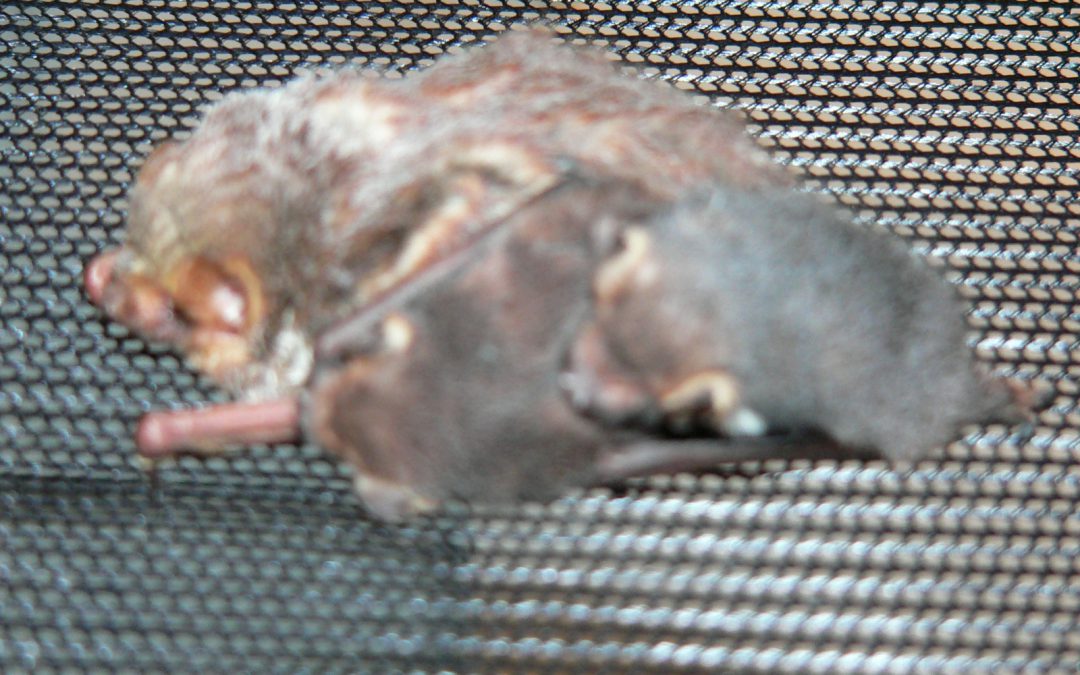
by Carrie Stevenson | Apr 7, 2015
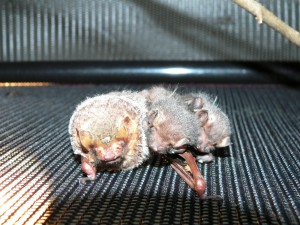
These young Seminole bat pups were separated from their mother and extremely vulnerable in the wild. The local Wildlife Sanctuary nursed them to health. Photo credit: Carrie Stevenson
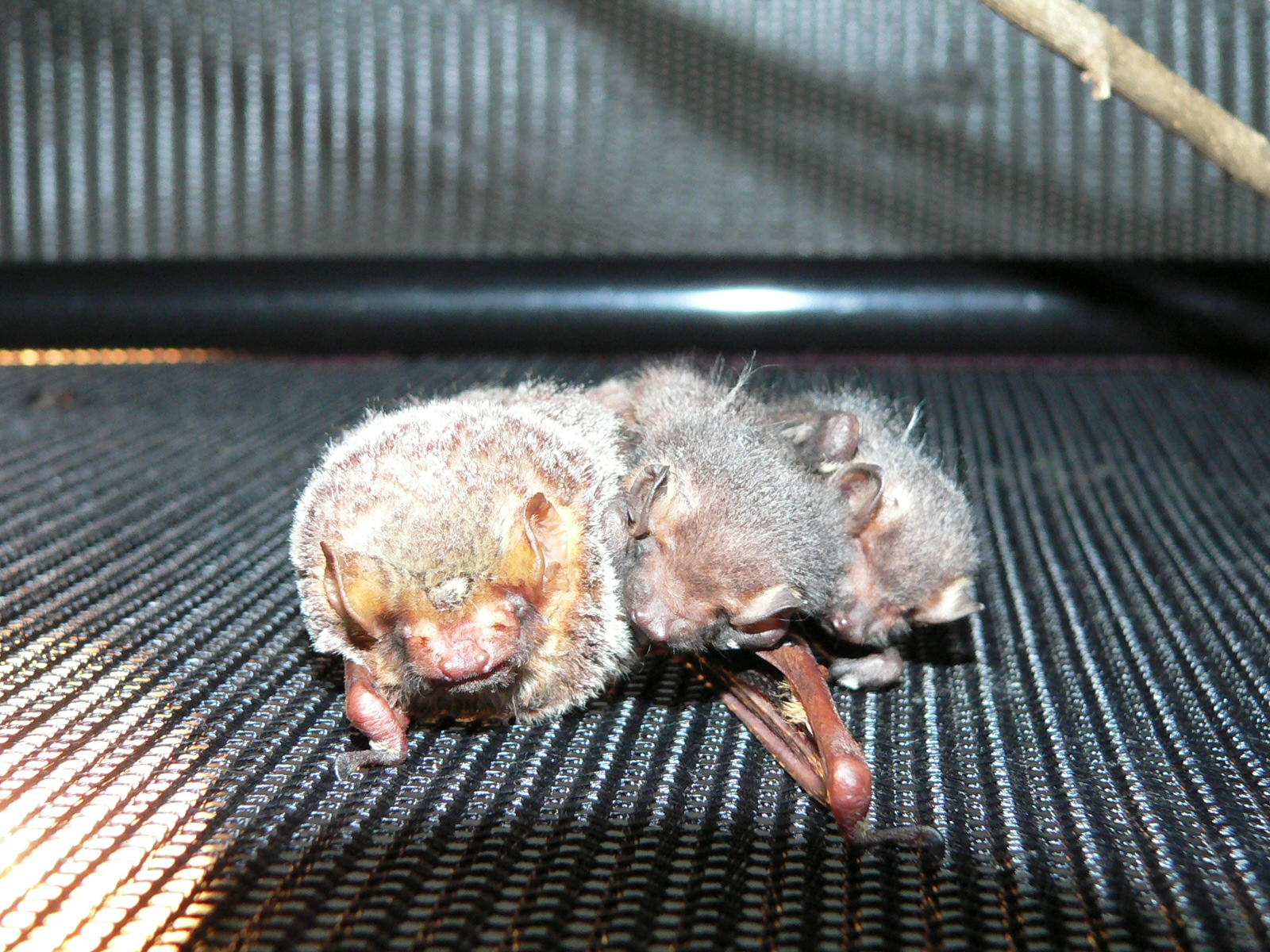 As spring commences and young wildlife of all species are born, everyone’s favorite flying, furry mammal begins roosting season. Ideally, bats will find homes in trees, caves, abandoned buildings, and bat houses, but sometimes they end up in a home. I receive calls often about how to best remove or exclude a group of bats living in an attic or garage. While there are countless benefits (most notably, efficient insect control) to having bats in one’s landscape or neighborhood, most people prefer they not share their own home with them.
As spring commences and young wildlife of all species are born, everyone’s favorite flying, furry mammal begins roosting season. Ideally, bats will find homes in trees, caves, abandoned buildings, and bat houses, but sometimes they end up in a home. I receive calls often about how to best remove or exclude a group of bats living in an attic or garage. While there are countless benefits (most notably, efficient insect control) to having bats in one’s landscape or neighborhood, most people prefer they not share their own home with them.
Bats have a slow reproductive cycle and declining populations in the United States, and are protected by several state laws. According to Florida Administrative Code 68A-9.010 under “Taking Nuisance Wildlife,” it is illegal in Florida to prevent bats from returning to any roosting location from April 16 to August 14. Female bats typically give birth during maternity season to one pup (or rarely, 2-3), which clings to the mother’s fur to nurse for their first few weeks and months of life. Being nocturnal, this means mothers and babies will be inside a dwelling during the day. Typically, if a homeowner is trying to exclude bats from a home, they will put up netting or seal a hole in an attic entry in the evening after bats have flown off to feed on insects at night. However, if this is done during roosting season, young bats left back in the roost while mothers are hunting can get trapped inside a building and will not survive.
This obviously has the potential to cause conflict between homeowners and the bat population. The Florida Fish & Wildlife Conservation Commission has regulatory oversight for bat-related issues, and they will work with citizens to arrange a positive outcome for both the property owner and the animals involved. Bats play an important role the ecosystem as efficient controllers of insect populations.
Unfortunately, bat populations are declining in North America due to a devastating disease called white-nose syndrome and loss of habitat. However, you can help these fascinating animals by installing a bat house in your yard. Keep in mind that bats attracted to bat houses prefer to be in open areas away from trees (where their predators hide), and the house should be installed at least 12 feet in the air. Bat houses can be purchased or built rather simply—keep an eye out for Extension workshops near you, or visit the UF Wildlife Ecology publication, “Effective Bat Houses for Florida” or Bat Conservation International’s website for simple instructions.
To learn more about bats and how to help them, visit this website or contact me or your local County Extension office!
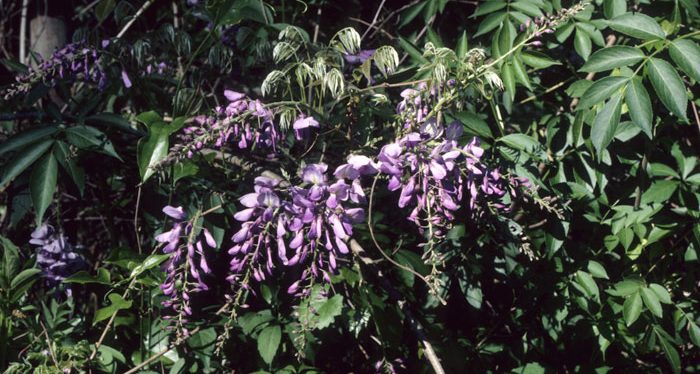
by Mary Salinas | Apr 6, 2015
 Maybe you have been seeing the Chinese wisteria, Wisteria chinensis, sporting its lavender blooms along the roadways this time of year. This vine may add a pleasant splash of color to the green leafy backdrop, but this is an invasive vine that has escaped our yards and gardens and is spreading on its own in natural communities.
Maybe you have been seeing the Chinese wisteria, Wisteria chinensis, sporting its lavender blooms along the roadways this time of year. This vine may add a pleasant splash of color to the green leafy backdrop, but this is an invasive vine that has escaped our yards and gardens and is spreading on its own in natural communities.
The University of Florida Assessment of Invasive Plants determined that this vine has caused long-term alterations in ecosystem processes and displaces native vegetation. According to the non-profit Florida Exotic Pest Plant Council (FLEPPC), Chinese wisteria is a category II invasive which means that the species has escaped cultivation and is spreading on its own into other unintended areas.
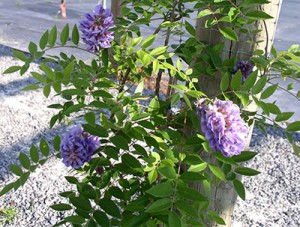
American Wisteria ‘Amethyst Falls’ at GCREC Teaching Gardens. Photo credit: UF/IFAS Extension.
Fortunately, there are several great alternatives to Chinese wisteria. A native vine, American wisteria, Wisteria frutescens, is a great alternative. The native cultivar ‘Amethyst Falls’ displays lovely fragrant lavender blooms in the spring and summer.
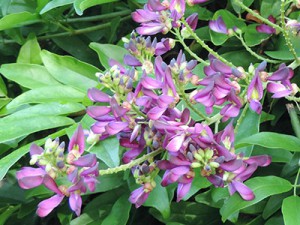
Evergreen Wisteria at the GCREC Teaching Garden. Photo credit: UF/IFAS Extension.
Another alternative is evergreen wisteria, Millettia reticulata, a twining vine (the stems twist around upright supports) that is semi-evergreen in the Florida panhandle. The deep mauve blooms appear throughout the summer months and persist often into the autumn.
So how do you get rid of the invasive Chinese wisteria? The vine can be severed at ground level and the stump immediately treated with a 25% solution of triclopyr or glysophate. There may be some resprouting of the vine from unaffected roots that would require retreating. Please click here for more details. The best time to control this vine is in the spring or summer when it is actively growing so that it will transport the herbicide to the roots and kill the plant.
For further information:
UF/IFAS Center for Aquatic and Invasive Plants: Chinese Wisteria
UF/IFAS Assessment of Invasive Plants: Chinese Wisteria
FLEPPC: 2013 List of Invasive Plants
UF/IFAS Gardening Solutions: American Wisteria ‘Amethyst Falls’
UF/IFAS Gardening Solutions: Evergreen Wisteria
















